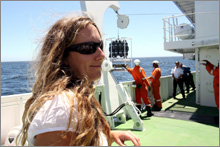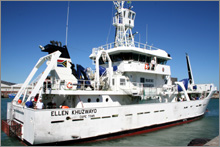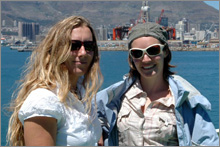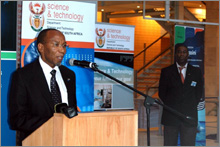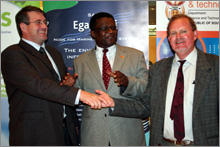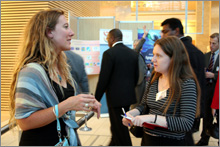SAEON launches its Egagasini Node with key stakeholders in attendance
|
A major highlight which drew considerable attention to SAEON and its
operations from a national and international Earth observation audience
was the launch of the SAEON Egagasini Node at the Ministerial Summit of
the Intergovernmental Group on Earth Observations (GEO).
The landmark Summit, which was held in Cape Town in November last year, attracted more than 600 ministers and officials from over 100 governments and international organisations.
Two months prior to the Summit, SAEON approached the Department of Science and Technology (DST), as the Summit hosts, for permission to launch the node as a side-event. Not only was permission granted, but the Minister of Science and Technology, Mosibudi Mangena, agreed to deliver the keynote address and undertake the official launch of the node.
A few weeks later, DST approached SAEON with the request to launch the South African Earth Observation Strategy (SAEOS) as part of the SAEON event. In the end, SAEON shared the launch event with two DST-associated initiatives, SAEOS and CEOS (Committee on Earth Observation Satellites).
Permission for the launch was also obtained from the GEO Secretariat in Geneva.
The research ship Ellen Khuzwayo
The Department of Environmental Affairs and Tourism’s branch Marine and Coastal Management (MCM), the host of the SAEON node for marine-offshore systems, was invited to participate in the launch.
MCM kindly made their newly launched research ship, the Ellen Khuzwayo and a number of their researchers available for three demonstration cruises which preceded the official launch function and which gave invited media, government decision-makers and other SAEON stakeholders the opportunity to see for themselves how marine science is conducted on board such a vessel, and how marine observation and monitoring contributes to the global pool of knowledge on the crucial issue of climate change.
It was also MCM’s CEO, Dr Monde Mayekiso, who proposed the name selected for the node. Egagasini is a Zulu word which means “Place of Waves”.
Day of the launch
The days leading up to the launch were windy, with intermittent rain, but the day of the launch dawned crisp and clear, to the relief of everyone involved in the organisation of the launch and particularly the cruises. The Ellen took to the open waters in brilliant sunshine.
All three cruises were fully booked, with a waiting list of stakeholders wishing to participate. Johan Pauw, Head of SAEON, Dr Juliet Hermes, Manager of the Egagasini Node, as well as SAEON and MCM staff and researchers were on hand to attend to the guests.
The evening’s celebratory launch event took the form of a cocktail reception at the Cape Town International Convention Centre. More than 300 guests attended the event, representing a large number of SAEON’s key stakeholders. SAEON was particularly pleased that the Director of the GEO Secretariat, Prof José Achache was able to attend the launch.
The Minister of Science and Technology, Mosibudi Mangena delivered the keynote address and formally launched both SAEOS and the SAEON Egagasini Node.
“SAEON is relatively unique in the southern hemisphere and is the first in Africa,” the Minister said in his speech. “Its innovative, integrated information management systems will strengthen scientific research and inform policy-making for many years to come.”
Minister Mangena lauded SAEON for the crucial role it has played in the formation of a network of environmental observatories for Southern Africa:
“The Environmental Long-Term Observatories of Southern Africa network, ELTOSA, launched in 2003, creates synergy among the observation networks of the Southern African countries,” he said. “It also has the effect of building sufficient critical mass in human and infrastructural capacity building for in situ earth observation in the region. The ELTOSA countries have since been collaborating to increase the effectiveness of regional earth observations and information.”
Minister Mangena also mentioned that the science councils, universities and research organisations, the South African Data Centre for Oceanography and the African Node for the Ocean Bio-geographic Information System will be prominent participants in the SAEON Egagasini Node.
“SAEOS and SAEON, with partners such as CEOS and GEO have critical roles to play,” he said. “Earth observations enable us to understand our planet better. This enables us to make smarter decisions, and deploy our resources more effectively. Our international partners, in turn, enable us to put our small individual resources together into a powerful global force for good.”
“The SAEON trades in long-term environmental information - information which will improve societal well-being and support our national priorities. My Department has recently identified global change as one of five grand challenges requiring particular attention in the next 10 years, and the SAEON will play a key role in addressing this challenge.”
Making waves in international marine science
After the event Dr Juliet Hermes said that the Egagasini Node, in keeping with its name, will be making waves in international marine science. “It will use South Africa’s geographical advantage in the Southern Oceans to garner information to inform climate change studies across the globe, and for marine resources management in the region,” she explained.
Dr Hermes said that she looked forward to the partnership with MCM, and thanked them for their contribution to the success of the launch.
Spreading the SAEON message
The SAEON issue of the South African Journal of Science, which covers the research papers of the first SAEON Summit, was distributed at the launch.
The launch event and demonstration cruises also received coverage in a wide range of media.


